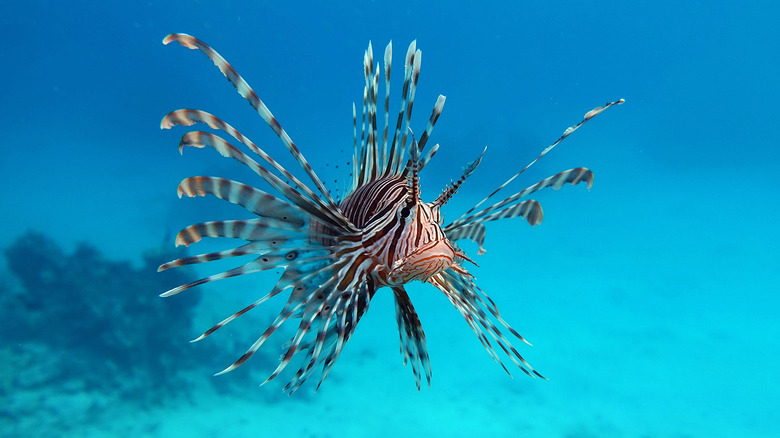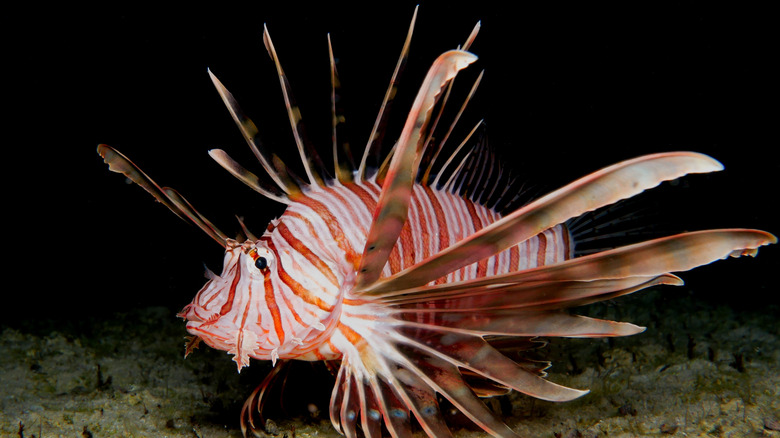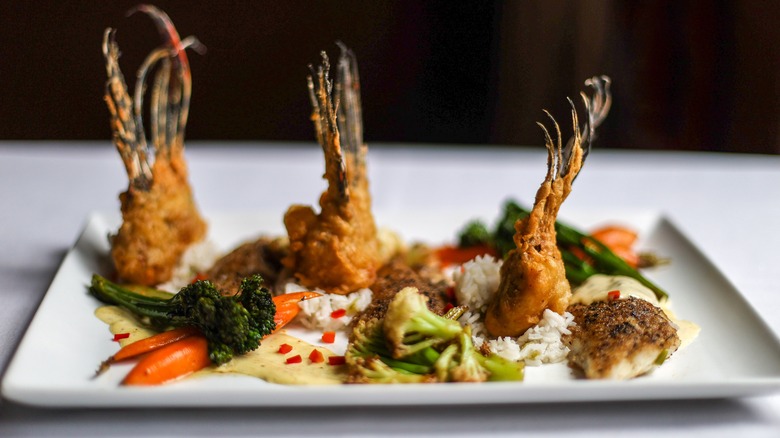What Are Lionfish And How Do You Safely Cook Them?
If you've ever spent time at your local aquarium shop, lionfish (Pterois volitans or Pterois miles) have probably caught your eye swimming through fabricated coral reefs. But, in recent years, awareness campaigns about its threat to oceanic life have taken shape on many fronts. "The reef is where you feel like you belong," April the rockfish says in the 2016 animated film Izzie's Way Home just before protecting young Izzie from a ferocious lionfish. In real life, the non-indigenous lionfish is threatening the reef where native fish call home, according to Jean-Michel Cousteau's Ocean Futures Society. From the warm waters of the United States down to the Caribbean islands, chefs and resorts are partnering with the organization to create awareness in an effort to cull the invasive species.
Chef Eric Ripert, for example, collaborates with The Ritz Carlton-Grand Cayman for the annual Cayman Cookout, where certain programming has centered around this important subject. "Since [lionfish] is an invasive species, it is helpful for restaurants to serve it since it helps save local species and ecosystems," Ripert told Tasting Table in an interview. Chef Irv Miller of Pensacola, Florida's Jackson's Steakhouse aligns with Ripert's notion by showcasing the fish consistently. Miller told Tasting Table, "This could help ensure the future of our native species."
But what if you want to take a deep dive into the world of lionfish for yourself? From learning its origins to how to treat this foe with precaution, this isn't your standard grocery store fare.
Where are lionfish found?
The National Ocean Service (NOS) describes lionfish as carnivorous, originating in the Indo-Pacific. Here, the Coral Triangle boasts more than 2,000 species of ocean life, including lionfish, with close to 600 reef-building coral species, according to World Wildlife Federation. Also known as zebrafish, it has a distinctive maroon and white striped body boasting poisonous fanlike fins and separated dorsal spines. With its unique appearance, the lionfish has become highly lucrative in the aquarium industry, per the National Ocean Service. Though the coral reefs of the South Pacific and Indian Ocean are their native habitat, the NOS notes that the predatory fish debuted state-side in the 1980s.
Preying on over 50 species of fish by cornering them with their venomous fins, lionfish now pose a real threat to the Atlantic's natural environment, according to NOS, adding that it is likely that the lionfish made its way here after aquarium release of non-regulated species in Florida. The Atlantic's currents encouraged northern migration, with lionfish popping up off the coast of North Carolina, South Carolina, and Georgia by the 2000s (via Florida Fish and Wildlife Conservation Commission). Even still, the commission says that the adult fish usually tend to stay put, explaining populations swelling to 200 adults per acre at times. Furthermore, the lionfish also pose a real threat in the Caribbean, where a reported 75% of coral reefs — which feed and provide for over 4 million people — are already in danger (via World Resources Institute).
The taste of lionfish taste and its nutrition
Chef Eric Ripert told Tasting Table that lionfish are flaky and firm with a delicate flavor similar to grouper, while chef Irv Miller adds that the flounder-like filets "beneath their red striped armor" are white, delicate, and buttery. Orlando Weekly adds that the firm texture of a cooked lionfish's taste is comparable to snapper or black sea bass.
As the lionfish is such an invasive species, eating it provides sustainable effects to the Atlantic region, it's one of the tastiest on the reef, per Lionfish.co. What's more, a Tremain and O'Donnell study shows that lionfish contains lower mercury levels than most other seafood hitting your plate, perhaps (as Lionfish.co suggests) because it's a small fish consuming other small fish which haven't built up enough of the harmful chemical in their systems. Other fish listed by the Florida Department of Health should only be eaten on a limited basis because of mercury levels, but the lionfish presents no comparable restrictions. So, if lionfish is an all-you-can-eat situation, it begs a closer look at other nutritional values of your newfound sustainable catch.
Rich in omega-3 fatty acids, Lionfish.co concludes a lower level of omega-6 fatty acids, thus an all-around cholesterol-busting powerhouse. With 18 grams of protein per serving and 25% of the daily recommended calcium consumption, the outlet lists a mere 80 calories per serving.
Where to source lionfish
"Acquiring fresh lionfish requires divers to spear and gather them for harvesting under near perfect weather conditions," chef Irv Miller told Tasting Table. He added that the fish are tricky to catch because they can't be baited and hooked, making spearfishing the only option for capturing lionfish. He and Ripert agreed that buying them straight from the divers is your best bet.
Divers can compete for cash prizes at events such as lionfish derbies and competitions, according to Oceana International. Lionfish removal and awareness days, such as the one that Florida Fish and Wildlife Conservation Commission promotes yearly, offer novices a chance to get in on the action. And, if you're not able to make it to Jackson's or the Cayman Cookout, where you can taste the delicacy prepared by pros, plenty of organizations can provide you with lists of regional restaurants serving lionfish like the one from the Reef Environmental Education Center.
But, if you really want to try your hand at preparing lionfish at home, there are ways to do that too. Since the 2016 green rating by Monterey Bay Aquarium, Whole Foods Market is a great lionfish resource for the home cook. Publix notes on its website to contact your local store's manager about bringing lionfish to your neighborhood store. There are also seafood markets, such as Wild Seafood Market and Exotic Meat Market, that will ship them frozen when available.
Safely preparing lionfish
Start with The Lionfish Cookbook released by Reef Environmental Education Center as part of Bermuda's "Eat 'em to Beat 'em" campaign. Still, chef Irv Miller told Tasting Table to mind the venomous rays when filleting, which can leave a painful sting for days, per the National Ocean Service. However, the venom can only affect you if injected because it is inactive once cooked, according to Oceana International. Start by lifting the spines out of the way, then cut down the back toward the tail and repeat the cut underneath.
Orlando Weekly suggests using puncture-proof gloves to remove the spines prior to filleting. But, in case you do get punctured by its spines or fins, no worries. The outlet assures that no one has died from such and recommends immersing the wound in hot water for 30-90 minutes. If the sting doesn't go away, a quick trip to the doctor may be in order.
Once the lionfish is ready to cook, chef Eric Ripert told us, "It is a very versatile fish and can be prepared many different ways, including grilled, sautéed, poached, etc." Chef Miller added to allow for a minimum whole lionfish weight of ¾ pound – 1½ pounds to yield nice size filets. Some of Miller's favored preparations are whole-fried and spice-rubbed. He's also a fan of lionfish throats batter-fried.
Even still, no matter how you eat lionfish, it's one more step toward sustaining the ecosystem of the world's oceans.




